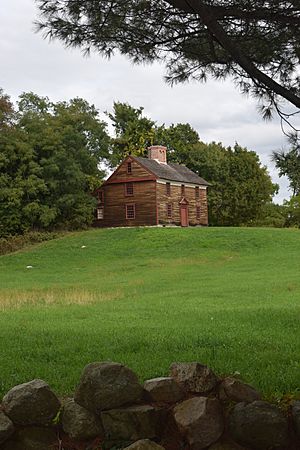Captain William Smith House facts for kids
Quick facts for kids Captain William Smith House |
|
|---|---|

The house in 2016
|
|
| General information | |
| Architectural style | Colonial |
| Location | Lincoln, Massachusetts, U.S. (Concord until 1754) |
| Address | North County Road |
| Coordinates | 42°27′03″N 71°17′19″W / 42.45086°N 71.28857°W |
| Completed | 1692 |
| Technical details | |
| Floor count | 4 (including the cellar) |
| Design and construction | |
| Main contractor | Benjamin Whittmore |
The Captain William Smith House is a very old and important house in Lincoln, Massachusetts, United States. It's part of the Minute Man National Historical Park, which helps tell the story of the American Revolutionary War. This house is special because it's connected to the very first battle of the Revolution, the 1775 battles of Lexington and Concord.
People believe the house was built in 1692, or maybe a bit earlier. At that time, this area was part of Concord. Today, it is thought to be the oldest house still standing in Lincoln.
The house is located on North County Road. This road is close to Battle Road, which was once called Bay Road. It's just a short distance from the Hartwell Tavern and the Samuel Hartwell House.
Contents
Who Lived in the Captain William Smith House?
The first person known to live in the house was a farmer named Benjamin Whittemore. He lived there until 1734.
Later, the house became the home of Captain William Smith (1746–1787). He was a very important person in Lincoln.
- He was the commanding officer of the Lincoln minutemen. Minutemen were special citizen soldiers ready to fight at a moment's notice.
- He was also the only brother of Abigail Adams. She was the wife of John Adams, who later became the second President of the United States.
Today, the National Park Service has restored the house. It looks just like it would have in 1775, during the time of the American Revolution.
The Smith Family Home
In 1758, William and Elizabeth Dodge bought the house. They used it as a place to rent out. When they moved to New Hampshire, they gave the house to their only daughter, Catharine Louisa Salmon.
Catharine married William Smith in 1771. They lived in the house with their three children: Elizabeth, Louisa Catharine, and William Jr.
The Smith family also had an enslaved person named Cato. Cato did not fight in the battles of Lexington and Concord. However, soon after the battles, on April 24, 1775, he joined the army. He became a soldier in Captain Smith's new company. This company was part of the 6th Massachusetts Regiment, led by Colonel John Nixon. Sadly, Cato died in New Castle, New York, in January 1777.
Captain Smith passed away in Philadelphia on September 3, 1787. He was 40 years old. By then, he had six children. Captain Smith's father, Reverend William Smith, had taken over ownership of the house in 1780. Catharine left Lincoln in 1795. She lived much longer than her husband, passing away in 1824.
A House Through Time
After the Smith family, the house had several different owners. In 1975, the Captain William Smith House became part of the Minute Man National Historical Park. This helped protect the house and its history for future generations.
Architecture of the House
The Captain William Smith House has a special design feature. Below the roofline on the front of the house, there is a curved decoration called a cove cornice. This type of cornice is very rare. There are only four examples left in Massachusetts.
- The Captain William Smith House
- The nearby Whittemore-Smith House
- A house in Danvers
- A house in Marblehead
The Battle Road Connection
The battles of Lexington and Concord began early in the morning on April 19, 1775. British soldiers marched right past the Captain William Smith House on their way to Concord. They also passed it again on their way back to Boston.
Three children of Ephraim and Elizabeth Hartwell, who lived nearby, were part of the Lincoln minutemen. Their names were Samuel, John, and Isaac. They fought at the Old North Bridge and along the battle road. All three later served in the American Revolutionary War.
The Midnight Ride and Warnings
On the night of April 18, Paul Revere and William Dawes were riding to warn people about the British soldiers. A British Army patrol stopped them nearby.
However, Samuel Prescott, who was riding with them, managed to escape. He jumped his horse over a wall and rode into the woods. Prescott then arrived at the Hartwell Tavern. He woke up Ephraim Hartwell and told him that the British soldiers were coming.
Ephraim sent his enslaved person, Violet, down the road. Violet's job was to alert Ephraim's son and his family. Mary, Ephraim's daughter-in-law, then passed the message to Captain William Smith. Because of these warnings, the minutemen received the news in time. They were able to get to Old North Bridge before the British soldiers arrived. Samuel Prescott also successfully made it to Concord to spread the alarm.
"The running battle back to Boston passed by Smith's house around 1:30 p.m. A British regular soldier who was wounded nearby was left in the care of Catharine Louisa, Captain Smith's wife. Even though she and a doctor from Lexington, Joseph Fiske, tried their best, the soldier died from his wounds two or three days later. He was buried near the farmhouse." – National Park Service


